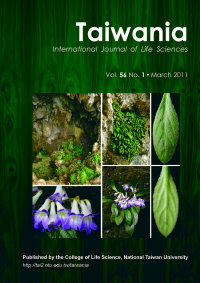Research Paper
Na, K and Ca Contents in Roots and Leaves of Three Glycine Species Differing in Response to NaCl Treatments
Wen-Yuan Kao
Published on: 23 March 2011
Page: 17 - 22
DOI: 10.6165/tai.2011.56(1).17
Abstract
It has been shown that three wild soybean species, Glycine soja, G. tomentella and G. tabacina, in Taiwan had different response to root-zone salinity and differences in leaf accumulation of Na and K might be responsible for the response. To further understand the mechanisms in relation to the differences among species in leaf accumulation of Na, K and Ca, in this study I compared the distribution of Na, K, and Ca not only in leaves but also in roots and calculated the sum of the ion contents in leaf and root (= ion content in roots + ion content in leaves) of the three soybean species receiving four different levels of NaCl treatments, 0, 17, 51 and 85 mM. Analysis of contents of K and Na in leaves and roots revealed that G. soja, the most sensitive species, and G. tomentella, the most tolerance species had similar sum of root and leaf Na contents under the same NaCl treatment, however, the former had significantly high leaf Na content than the later. G. tabacina, the medium sensitive species, had the least sum of root Na and leaf Na contents and medium leaf Na content. In G. soja, increasing accumulation of Na in leaves with increasing treatment NaCl concentration might hamper the uptake of K in roots resulting in decreases in the sum of K contents in roots and leaves. There is no evidence that salinity could impair Ca uptake in the three wild soybean species. These results suggest that differential sensitivity to root-zone salinity among the three species is mainly due to their differential ability to control the allocation of salt away from leaves and to some extent restrict Na uptake at root level.
中文摘要
先前研究發現臺灣三種野生大豆 (Glycine soja, G. tomentella 和G. tabacina) 對土壤鹽分濃度增加有不同程度的反應,G. tomentella耐受度最好,G. tabacina其次,G. soja 最不耐,且其敏感度和葉部組織內鈉和鉀的累積量有相關 (Kao et al., 2006)。為了瞭解是什麼機制導致這三種野生大豆部葉部組織內有不同的鈉、鉀和鈣的累積量,本文延伸先前研究,進一步分析這三種野生大豆在四種不同鹽分濃度 (0、17、51和85 mM) 處理下其鈉、鉀和鈣分別在根部、葉部的含量、以及計算根和葉含量總合 (根部加上葉部的含量) 變化。結果在相同鹽分濃度處理下G. soja 和G. tomentella有類似的根和葉鈉含量總合,然而前者葉鈉含量顯著高於根鈉含量,後者則有相反的反應。比較G. tabacina和G. tomentella則發現雖然前者根部和葉部鈉含量總合顯著低於後者,然而其葉鈉含量比後者高。當較多的鈉累積在G. soja的葉部時,可能降低其根對鉀的吸收,以至於在51和85 mM處理下,其根部和葉部鉀含量總合顯著減少。鹽濃度增加並沒有減少大豆植株根部和葉部的鈣含量。綜合上述,大豆耐鹽逆境的機制應該和其是否有能力減低葉部鈉含量(主要機制)以及減少根部對鈉的吸收(次要機制)有關。
Keyword: Glycine,growth,ion contents,salinity,wild soybean,Glycine,生長,離子含量,鹽逆境,野生大豆


